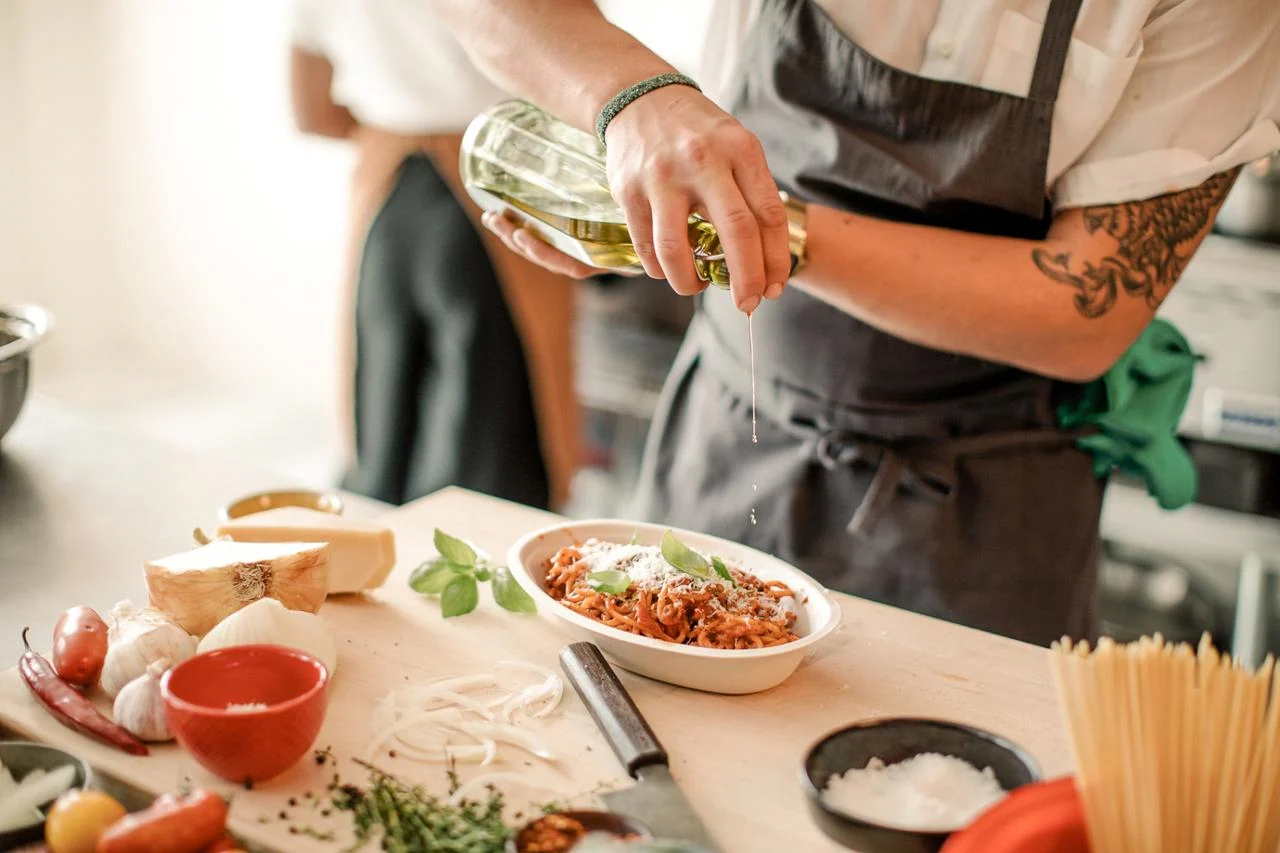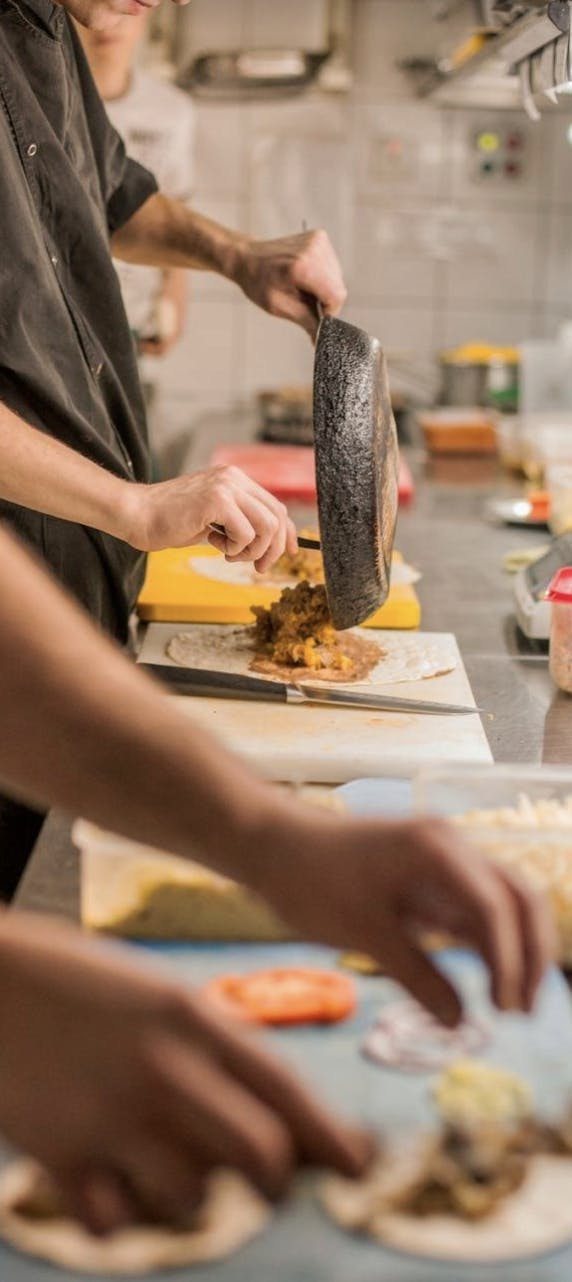5 Restaurant Inventory Management Best Practices
Table of Contents
CloudKitchens
How many tacos can be delivered from a 1000sqft restaurant?
The same amount as a 200sqft ghost kitchen.

It’s Saturday night, and you and your partner manage to snag the last two-top at the most acclaimed restaurant in town. The energy is effervescent. The aromas are divine. And as you take in the swirling symphony of the front-of-house and kitchen staff around you, you’re mesmerized by their flawless delivery of so many incredible dishes on such a buzzing night.
Restaurant inventory management is the unsung hero working inside every efficient restaurant business, from a food truck to a ghost kitchen. It’s the mysterious wisdom gleaming in the manager’s eye and the crystal ball of ingenious menu offerings.
Smells enticing, doesn’t it? Here’s how to put inventory control into practice.
What is restaurant inventory management?
Food inventory management is the practice of sourcing, tracking, and expensing every ingredient that a restaurant business uses. Just like product inventory tracking in a retail or apparel store, food inventory must be overseen and measured in a restaurant.
A restaurant’s inventory management accomplishes three main tasks:
- Controlling and tracking food costs
- Tracking ingredient volume at all times
- Controlling and tracking food waste
Types of restaurant inventory
So what exactly falls in the category of “food inventory” in a restaurant? First and foremost, any ingredient used to create the final product that goes on the plates and floats onto the tables of your hungry customers. Other supplies, like cooking appliances, can also qualify.
Food inventory can include any of the following:
- Fruits, vegetables, meats, and poultry
- Dry goods like pasta, beans, and rice
- Spices, herbs, and other garnishes
- Liquids like soda, beverages, and liquor
- Cooking equipment and appliances
- Linens, utensils, and serving ware
Food inventory will differ with different types of restaurant establishments. For example, when looking at food trucks vs. restaurants that are brick and mortar, this business model will require less inventory to operate, reducing some overhead costs.

Benefits of restaurant inventory management
Imagine a restaurant that had no sense of the menu item ingredients they had on hand. Perhaps in rare cases, this could look like a cutting-edge farm-to-table experiment or a high-stakes episode of Chopped. But in most cases, a restaurant without inventory cannot run.
A restaurant inventory management system allows restaurants to produce, serve, and advertise a planned menu from open ‘til close. It prepares them to deliver dishes, drinks, and desserts in the face of unknown customer volume and order choices without faltering.
If you’ve ever wondered how it’s even possible as you dine amongst a sea of hungry New Yorkers on a bustling Friday night, you’re not alone. Behind the scenes of a restaurant operation is a meticulous, heroic inventory counting system saving patrons from dreaded “we ran out” woes.
Restaurant inventory management helps:
- Optimize food stock to maximize profit margin
- Mitigate food waste (and subsequent dollars wasted)
- Forecast supplies needed based on past demand trends
- Automatically track food supply to eliminate manual counting
5 tips for managing restaurant inventory
One thing in the restaurant industry that you can always guarantee is its constant unpredictability. What with ebbing foot traffic, varying food costs, and changing economic conditions, restaurant management is not for the faint of heart—or those impermeable to pivoting.
In the face of uncertainty, restaurant inventory management should be your constant and one of the top priorities when learning how to start your own restaurant. This is the aspect that restaurant owners can control. And when they do, each menu item becomes fresher, the dumpster becomes lighter, and the customers become delighted to return.
Take a look at these five expert tips on managing restaurant inventory.
1. Enlist a quality inventory management tool
The best decision a restaurant owner can make is to invest in quality inventory and kitchen management software. Before software, restaurant owners were forced to track food inventory manually. While some still do (and manual tracking is helpful in certain cases), having automated restaurant management software is unmatched in efficiency and ease.
Inventory management tools can:
- Automatically track inventory levels in real-time
- Recommend what products to refill and when
- Predict what products will be popular later
- Track food waste and corresponding profitability
2. Hire staff that you can trust
As the restaurant owner, you can’t be everywhere at once (as much as you might want to be). That means you’re going to need to turn the food inventory task over to a trusted employee.
Typically, inventory management is entrusted to a manager or associate manager of a restaurant as they’re expected to perform higher-level duties. It’s also helpful for a manager to know inventory levels as they oversee the restaurant operations.
The moral here is to keep trustworthiness at the top of your hiring priorities if you’re exploring the world of traditional restaurant ownership. Delegate this important responsibility to a staff member with keen attention to detail and strong math skills.
3. Track inventory consistently
Like any well-oiled system, an inventory management operation requires consistency. Restaurants typically review inventory data on a weekly basis. Depending on the customer volume, inventory levels might be reviewed nightly.
By checking inventory levels, waste, and costs on the same day and time on a regular basis, you’re more likely to see the most accurate picture of your kitchen. For example, reviewing the inventory count on a Sunday night one week versus a Tuesday night the next week is not going to reflect the same picture of low ingredients.
4. Prepare a backup system
While digital inventory management software is immensely helpful, problems can occur. If your inventory system goes down, you need a backup method to keep track of food while business chugs on.
The best tactic for manual tracking of restaurant inventory is an inventory sheet. Inventory sheets can live on paper or an Excel spreadsheet and keep track of:
- The amount of every ingredient in the kitchen, by number or weight
- Which ingredients are running low and need replenishment
- Which ingredients need to be purchased in the next buying round
5. Learn from data trends
Whether you employ a manual or automated inventory management tool, these systems garner valuable data for your food business. Like the food itself, this data shouldn’t go to waste.
Throughout 6 to 12 months and beyond, an inventory management system can inform which ingredients are most popular, which ingredients are being wasted most often, and which dishes are turning the most profit for a restaurant.
The key here is to nourish your inventory system with consistent, accurate information. The more you put into the system, the better your profit margins can become.
Restaurant inventory terminology
If you’ve ever worked in a restaurant, you know that the culture can feel like another world entirely. There are acronyms to learn, numerical codes to enunciate across the expedition line, and a seemingly unique language altogether.
Restaurant inventory management is a bustling city in this world with a language all its own. If you’re going to succeed at this crucial craft, it’s important to understand the codes and lingo that go along with it.
Here are some acronyms and phrases most commonly used in restaurant inventory:
- Cost of Goods Sold (COGS): This is the final balance of a restaurant’s total inventory, calculated by the starting inventory plus newly purchased inventory minus the inventory left over after a recorded night or week.
- Usage: The amount of an inventory product used in a given period. This is usually calculated in a dollar amount and informs the yield, or how much money a restaurant can make on a product.
- Sitting inventory: This is a term used to describe the amount of an ingredient you have in the restaurant at that moment and should be measured in consistent units, like dollars or pounds.
- Dead stock: If sitting inventory is ripe for regular use, the dead stock is the collection of products collecting dust on the refrigerator shelves. Dead stock doesn’t sell well and isn’t predicted to sell well in the future, which can hurt a restaurant’s profits.
- Par level: This is the amount of any one ingredient you need to fulfill a dish or order in a given period. The par level aims close to the necessary amount. Too low, and orders can’t be fulfilled. Too high, and food is wasted.
- Catch weight: Natural food, like produce and meat, fluctuates in weight. To standardize this, a measurement called a catch weight is used, providing flexibility in weight margins and counterbalancing yields accordingly.
- First in, first out (FIFO): An important lesson on food safety and a helpful way to use inventory efficiently, FIFO ensures that the oldest ingredients get used up first. That way, fewer ingredients expire or go bad by their expiration date.
- Inventory turnover ratio: This rate shows a restaurant how much of their purchased inventory they sold over a given period. If a restaurant’s inventory turnover ratio is 80%, that means they sold 80% of the ingredients they purchased.
Free time to perfect your inventory management at CloudKitchens
Restaurant inventory management is one of the most important aspects of running a successful restaurant. It’s the lifeblood of the operation, steering the ship toward satisfied customers and a lucrative bottom line.
When you operate your restaurant with CloudKitchens, you can spend more time homing in on an impeccable inventory. CloudKitchens provides an entire commercial kitchen and a seamlessly integrated point-of-sale system all at your fingertips—so you can whip, stir, and sautée with an empowered pulse on your operations.
Whether you’re new to the restaurant scene, want to expand your reach, or working on establishing an entire chain of unforgettable flavor, CloudKitchens can help you reach your food business goals. Take your first step today into your future new kitchen.
We have locations across the United States, so whether you need commercial kitchens in Austin, commercial kitchens in Orlando, commercial kitchen rentals in Los Angeles, or ghost kitchens in San Diego…we’ve got you covered.
Explore ghost kitchen locations across the US:
- Ghost kitchens in San Francisco
- Ghost kitchens in LA
- Ghost kitchens in NYC
- Ghost Kitchens in Toronto
- Ghost Kitchens in Atlanta
- Ghost Kitchens in Dallas
- Ghost Kitchens in Chicago
- Ghost Kitchens in Denver
- Ghost Kitchens in Miami
| DISCLAIMER: This information is provided for general informational purposes only and the content does not constitute an endorsement. CloudKitchens does not warrant the accuracy or completeness of any information, text, images/graphics, links, or other content contained within the blog content. We recommend that you consult with financial, legal, and business professionals for advice specific to your situation. |
Sources:
NetSuite. 8 Best Practices in Restaurant Inventory Management. https://www.netsuite.com/portal/resource/articles/inventory-management/restaurant-inventory-management.shtml
BlueCart. Restaurant Inventory Management: 5 Benefits and Best Tips. https://www.bluecart.com/blog/restaurant-inventory-management-matters
Toast. The Glossary of Restaurant Inventory Management Terms to Know. https://pos.toasttab.com/blog/on-the-line/restaurant-inventory-management-terms
More insights & stories
There’s more where that came from.
Get in the know and check out our additional insights



